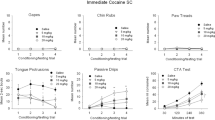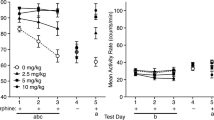Abstract
A Pavlovian conditioning experiment was conducted to determine whether morphine (6 mg/kg, IP) could act as a conditioned stimulus (CS) when paired with an electric shock unconditioned stimulus (US), and later produce a conditioned suppression of drinking (CR) in water deprived rats. Seven groups were tested for conditioning after exposure to one of the following conditioning procedures: (1) morphine paired with shock; (2) morphine alone with no shock; (3) shock but no morphine; (4) no shock and no morphine; (5) morphine paired with vocalizations of shocked rats; (6) saline paired with shock; (7) saline alone with no shock. Groups 1 and 2 tested whether morphine could act as a CS. Groups 3 and 4 tested for sensitization. Group 5 tested whether exposure to the vocalizations of other rats could act as a US when paired with a morphine CS. Groups 6 and 7 tested whether cues associated with the injection procedure could act as a CS. Only subjects in group 1 showed conditioned suppression of drinking, when compared to control groups. Overall, the results indicate that morphine could act as a conditioned stimulus and that several of the more obvious possible sources of artifact did not significantly contribute to the CR that it produced.
Similar content being viewed by others
References
Carey RJ (1989) Stimulant drugs as conditioned and unconditioned stimuli in a classical conditioning paradigm. Drug Dev Res 16:305–315
Carey RJ (1991) Pavlovian conditioning between co-administered drugs: Elicitation of an apomorphine-induced antiparkinsonian response by scopolamine. Psychopharmacology 104:463–469
Cook L, Davidson A, Davis DJ, Kelleher RT (1960) Epinephrine, norepinephrine and acetylcholine as conditioned stimuli for avoidance behavior. Science 131:990–991
Cunningham CL, Linakis JG (1980) Paradoxical aversive conditioning with ethanol. Pharmacol Biochem Behav 12:337–341
Davey VA, Biederman GB (1991) Methodological issues in drug-drug conditioning in rats: nonassociative factors in heart rate and avfail. Behav Neurosci 105:850–859
Greeley J, Le DA, Poulos CX, Cappell H (1984) Alcohol is an effective cue in the conditional control of tolerance to alcohol. Psychopharmacology 83:159–162
Lett BT (1983) Pavlovian drug-sickness pairings result in the conditioning of an antisickness response. Behav Neurosci 97:779–784
Lett BT (1986) Conditioned slowing of stomach emptying produced by Pavlovian pairings of a drug CS or place with lithium chloride. Psychopharmacology 90:49–53
Lett BT (1992) Pairings of a drug or place conditioned stimulus with lithium chloride produce conditioned sickness, not antisickness. Behav Neurosci 106:106–111
MacQueen GM, Siegel S (1989) Conditional immunomodulation following training with cyclophasphamide. Behav Neurosci 103:638–647
Martin GM (1982) Examination of factors which might disrupt a learned association between pentobarbital and LiCl. Learn Motiv 13:185–199
Martin GM (1983) Effect of pairings of pentobarbital with lithium chloride on the capacity of pentobarbital to maintain a conditioned aversion. Behav Neural Biol 39:145–148
Martin GM, Gans M, van der Kooy, D (1990) Discriminative properties of morphine that modulate associations between tastes and lithium chloride. J Exp Psychol [Animal Behav Proc] 16:56–68
Miczek KA (1991) Tolerance to the analgesic, but not discriminative stimulus effects of morphine after brief social defeat in rats. Psychopharmacology 104:181–186
Overton DA, Shen CF, Tatham TA (1993) Centrally acting drugs act as conditioned stimuli in a conditioned suppression of drinking task. Psychopharmacology 112:270–276
Rescorla RA (1985) Facilitation and inhibition. In: Miller RR, Spear NE (eds) Information processing in animals: conditioned inhibition. Erlbaum, Hillsdale, NJ, pp 299–326
Revusky S (1984) Associative predispositions. In: Marler P, Terrace HS (eds) The biology of learning. Springer, Berlin Heidelberg New York, pp 447–460
Revusky S (1985) Drug interactions measured through taste aversion procedures with an emphasis on medical implications. Ann NY Acad Sci 443:250–271
Revusky S, Reilly S (1990a) Dose effects of heart rate conditioning when pentobarbital is the CS and amphetamine is the US. Pharmacol Biochem Behav 36:933–936
Revusky S, Reilly S (1990b) When pentobarbital is the conditioned stimulus and amphetamine is the unconditioned stimulus, conditioning depends on the type of conditioned response. Behav Neurosci 104:693–703
Revusky S, Taukulis HK, Parker LA, Coombes S (1979) Chemical aversion therapy: Rat data suggest it may be counter-therapeutic to pair an addictive drug state with sickness. Behav Res Ther 17:177–188
Revusky S, Davey V, Zagorski M (1989) Heart rate conditioning with pentobarbital as a conditioned stimulus and amphetamine as an unconditioned stimulus. Behav Neurosc 103:296–307
Ross RT, Holland, PC (1982) Serial positive patterning: Implications for “occasion setting”. Bull Psychon Soc 19:159–162
Silverman PB (1990a) Classically conditioned ethanol stimulus control of a motor behavior. Alcohol 7:489–492
Silverman PB (1990b) Direct dopamine agonist-like activity conditioned to cocaine. Pharmacol Biochem Behav 37:231–234
Silverman PB, Grabowski J, Lane KE (1992) Rotational behavior as a classically conditioned response to pentobarbital administration. Eur J Pharmacol 212:165–169
Taukulis HK (1982) Attenuation of pentobarbital-elicited hypothermia in rats with a history of pentobarbital-LiCl pairings. Pharmacol Biochem Behav 17:695–697
Taukulis HK (1986a) Conditional hyperthermia in response to atropine associated with a hypothermic drug. Psychopharmacology 90:327–331
Taukulis HK (1986b) Conditional shifts in thermic responses to sequentially paired drugs and the “conditional hyperactivity” hypothesis. Pharmacol Biochem Behav 25:83–87
Taukulis HK, Brake LD (1990) Therapeutic and hypothermic properties of diazepam altered by a diazepam-chlorpromazine association. Pharmacol Biochem Behav 34:1–6
Turner EG, Altshuler HL (1976) Conditioned suppression of an operant response usingd-amphetamine as the conditioned stimulus. Psychopharmacology 50:139–143
Wilken LD, Cunningham CL, Fitzgerald RD (1982) Pavlovian conditioning with ethanol and lithium: effects on heart rate and taste aversion in rats. J Comp Physiol Psychol 96:781–790
Author information
Authors and Affiliations
Rights and permissions
About this article
Cite this article
Bormann, N.M., Overton, D.A. Morphine as a conditioned stimulus in a conditioned emotional response paradigm. Psychopharmacology 112, 277–284 (1993). https://doi.org/10.1007/BF02244922
Received:
Revised:
Issue Date:
DOI: https://doi.org/10.1007/BF02244922




